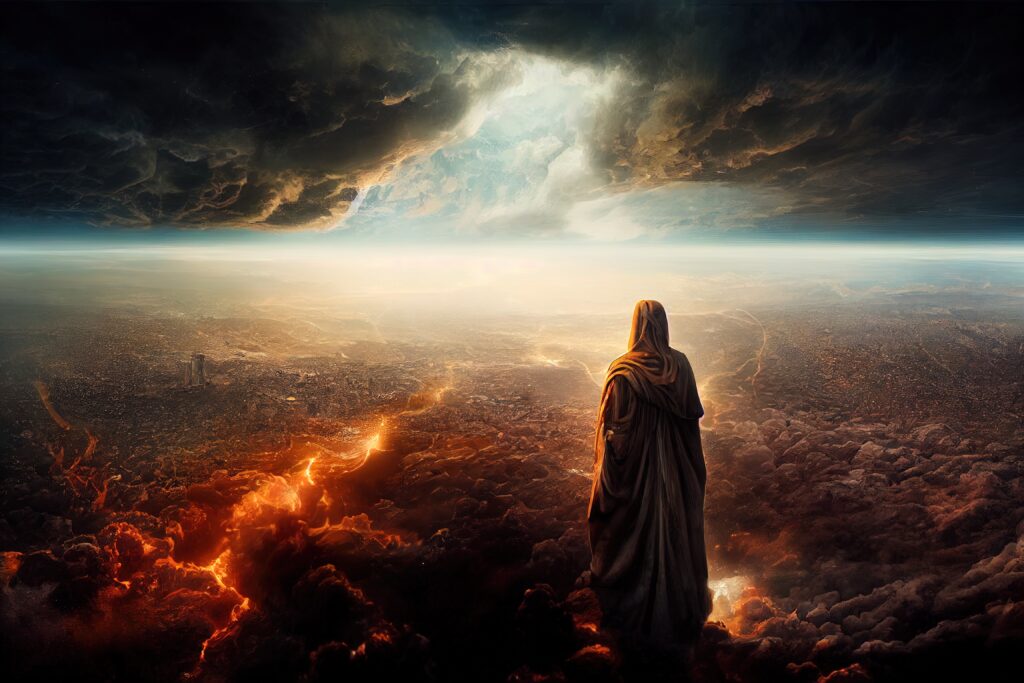
The God Man.
“Then I saw a Lamb that looked as if it had been slaughtered, but it was now standing between the throne and the four living beings and among the twenty-four elders. He had seven horns and seven eyes, which represent the sevenfold Spirit of God that is sent out into every part of the earth. He stepped forward and took the scroll from the right hand of the one sitting on the throne. – Revelation 5:6-7. NLT
A great cosmic conflict is the backdrop to the heavenly Scene in Revelation 4 and 5. A striking aspect of these two chapters is the total absence of satan, in spite of the fact that the heavenly crisis must have something to do with the cosmic conflict (see Rev. 2:9, 24). But the role of Satan in Revelation 4 and 5 is clarified in Revelation 12:10. This verse summarizes the scene of chapter 5 in terms of Christ’s coming to power. But His coming to power is paired with the casting down of Satan, the “accuser of our brothers”. The verse clarifies that Satan accuses the brothers “day and night.” This act is strikingly reminiscent of Revelation 4:8, where the four living creatures sing the triple holy song “day and night.” Their constant praise drowns out the constant accusations of Satan, the originator of lies (John 8:44), which are no longer heard or seen. Satan is absent from the scene of chapters 4 and 5 because he has already been defeated and cast out on account of the Cross.
God is portrayed in Revelation 4-5 as the all-powerful Creator. It seems that He can do anything He wants. But when a seemingly insurmountable problem arises (Rev 5:1-4), the solution is a stunner! God solves the greatest problem in the universe through a slaughtered Lamb!
Why doesn’t an all-powerful God solve problems through power? Why doesn’t He just MAKE things happen? Why does He take such a huge risk by sending His Son to this earth, knowing that He will be rejected and brutally murdered?
The Book of Revelation encourages Christians to see the experiences of ancient Israel as a model for Christian action and experience today. The Lamb in Revelation 5 is a slaughtered lamb, which reminds us of the Hebrew sanctuary and its sacrifices. The plagues of Revelation are modelled on the plagues that fell upon ancient Egypt. It was the blood of the Passover Lamb that protected the Israelites from the worst of those plagues. Similarly, the blood of Jesus protects His people during God’s judgments on humanity (Rev 7:3; 12:11). Just as the original Israelites became a kingdom of priests at Mount Sinai, so the followers of Jesus are a kingdom of priests drawn from every nation, tribe, language and people (Rev 5:9-10).
Paul associates the crossing of the Red Sea with Christian baptism in 1 Cor 10:1-4. Now archaeologists are not exactly certain where the Israelites made their crossing. Some even suggest that it was not the Red Sea, but the “sea of reeds,” which they identify with a lake north of the Red Sea near the Suez Canal today.
The Exodus is a model for Christian experience today. Our personal Exodus occurs when our old nature is buried in baptism and we rise to newness of life (Rom 6:3-4).
The sealed scroll contains the mystery regarding His plans to solve the sin problem and save fallen humanity. The full realization of that mystery will occur at the second coming. Why is Christ the only One in the entire universe worthy to take the sealed scroll and unseal it?
The greatest of the resources God has provided is described in this chapter. “While we were yet sinners” (Rom 5:8), He has already provided a Lamb to remedy the crisis of sin in our lives. But even before the Lamb was slain at the cross, He became worthy. The Lamb is one of the many symbols of the humanness of Jesus.
Since divinity cannot die, humanness was a pre-requisite for opening the scroll. The Creator had to become a creature. Because the Lamb was human, He could also die to redeem the human race. But there is a further qualification that was needed: “To him who sits on the throne and to the Lamb be praise and honour and glory and power. . . !” – Revelation 5:13, NIV. Jesus is not only worthy because He is human and He died, He is also worthy because He is divine. This combination of qualities makes Him unique in all of history. He carefully arranged the remedy for our greatest need long before we needed it. That’s what makes the Lamb so special in the book of Revelation.
Think about what this teaches: the one who created not just us and our world, but the entire cosmos, also was the “lamb who was slain” (Rev 5:12 NKJV) for us. What hope does this teaching present amid a world full of pain and turmoil?
